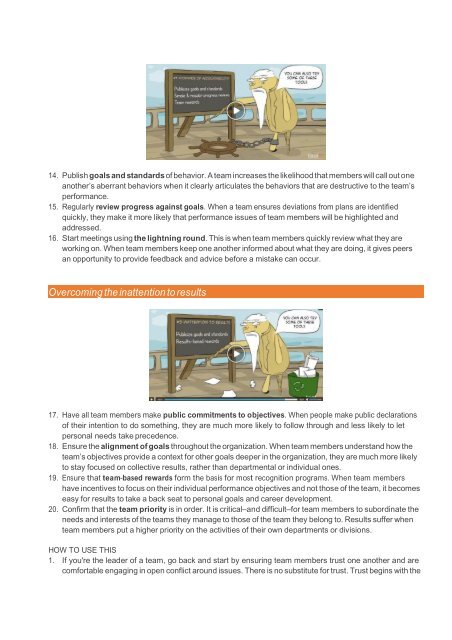2020 iLEAD e-book
- No tags were found...
Create successful ePaper yourself
Turn your PDF publications into a flip-book with our unique Google optimized e-Paper software.
14. Publish goals and standards of behavior. A team increases the likelihood that members will call out one<br />
another’s aberrant behaviors when it clearly articulates the behaviors that are destructive to the team’s<br />
performance.<br />
15. Regularly review progress against goals. When a team ensures deviations from plans are identified<br />
quickly, they make it more likely that performance issues of team members will be highlighted and<br />
addressed.<br />
16. Start meetings using the lightning round. This is when team members quickly review what they are<br />
working on. When team members keep one another informed about what they are doing, it gives peers<br />
an opportunity to provide feedback and advice before a mistake can occur.<br />
Overcoming the inattention to results<br />
17. Have all team members make public commitments to objectives. When people make public declarations<br />
of their intention to do something, they are much more likely to follow through and less likely to let<br />
personal needs take precedence.<br />
18. Ensure the alignment of goals throughout the organization. When team members understand how the<br />
team’s objectives provide a context for other goals deeper in the organization, they are much more likely<br />
to stay focused on collective results, rather than departmental or individual ones.<br />
19. Ensure that team-‐based rewards form the basis for most recognition programs. When team members<br />
have incentives to focus on their individual performance objectives and not those of the team, it becomes<br />
easy for results to take a back seat to personal goals and career development.<br />
20. Confirm that the team priority is in order. It is critical–and difficult–for team members to subordinate the<br />
needs and interests of the teams they manage to those of the team they belong to. Results suffer when<br />
team members put a higher priority on the activities of their own departments or divisions.<br />
HOW TO USE THIS<br />
1. If you're the leader of a team, go back and start by ensuring team members trust one another and are<br />
comfortable engaging in open conflict around issues. There is no substitute for trust. Trust begins with the

















